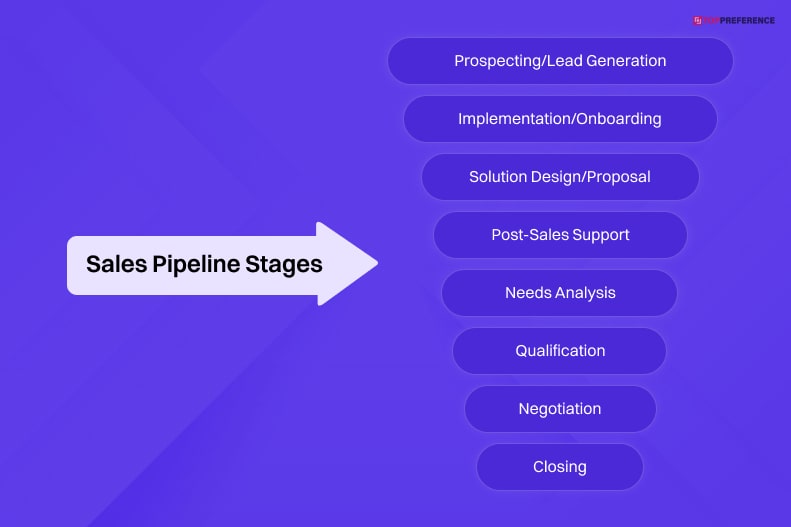What Are The Sales Pipeline Stages In CRM?
Do you want to know the different sales pipeline stages related to CRM? If your answer to this question is a yes, then you have reached the right place.
CRM systems are designed to manage interactions and relationships with customers. They offer instruments for managing leads, automating marketing campaigns, tracking customer data, and improving customer service.
CRM systems assist businesses in developing strong customer relationships, increasing customer satisfaction, and driving sales growth by centralizing customer information and fostering personalized interactions.
However, there are several stages that take place in doing this. And these are the sales pipeline stages. Keep reading his blog till the end to learn more about them?
What Is Sales Pipeline In CRM?��

In CRM (Customer Relationship Management), a sales pipeline refers to the visual representation or a systematic view of the sales process and all the potential deals or opportunities a salesperson or team is actively pursuing. It provides a snapshot of where each opportunity stands in the sales cycle and helps track the progress of deals from initial contact to closure.
The sales pipeline typically consists of multiple stages, as mentioned in the previous response, which represent the different steps involved in converting a lead into a customer. Each stage represents a milestone or action point in the sales process.
Purpose Of A Sales Pipeline��

Now that you know what Sales Pipeline is, it is time for you to learn about the purpose of having the same. And if that is what you want to know, keep reading this article till the end.
The sales pipeline serves several purposes. They are as follows:
1. Tracking and Visibility: ��
It allows sales teams and managers to have a clear view of all the deals in progress. By visualizing the pipeline, they can quickly assess the health of the sales process, identify bottlenecks or areas of improvement, and allocate resources effectively.
2. Forecasting: ��
The pipeline helps in forecasting future sales revenues based on the opportunities at each stage. By analyzing historical conversion rates and the velocity at which deals progress through the pipeline, sales managers can make predictions about future sales performance.
3. Prioritization: ��
Salespeople can prioritize their efforts and focus on the opportunities that are most likely to convert into closed deals. By analyzing the pipeline, they can identify high-value prospects, allocate time and resources accordingly, and engage in targeted activities to move deals forward.
4. Collaboration and Accountability: ��
The pipeline facilitates collaboration among team members by providing a shared understanding of the status and progress of each opportunity. It promotes accountability as it becomes evident which deals require attention and follow-up, ensuring that opportunities don�t fall through the cracks.
5. Decision Making: ��
Sales leaders can use the pipeline data to make informed decisions about resource allocation, sales strategies, and process optimization. By analyzing the pipeline metrics, they can identify trends, spot potential issues, and take proactive measures to improve sales performance.
Overall, the sales pipeline in CRM serves as a visual representation and management tool that helps sales teams organize, track, and prioritize their efforts, ultimately leading to increased efficiency and improved sales outcomes.
What Are The Sales Pipeline Stages?��

In a CRM (Customer Relationship Management) system, sales pipeline stages refer to the various steps or phases that a sales opportunity goes through from its initial identification to its closure.
These stages help sales teams track and manage their deals, monitor progress, and make informed decisions about resource allocation and sales forecasting. While the specific stages may vary depending on the organization and industry, here are some common sales pipeline stages:
1. Prospecting/Lead Generation: ��
This is the initial stage where potential leads or prospects are identified and qualified. It involves activities such as lead capture, lead scoring, and lead qualification.
2. Qualification: ��
In this stage, the leads are further evaluated to determine their potential as viable sales opportunities. This involves assessing factors such as budget, authority, need, and timeline (BANT criteria).
3. Needs Analysis: ��
At this stage, a salesperson engages with the prospect to understand their specific needs, pain points, and requirements. The goal is to gather information that will help in tailoring a solution.
4. Solution Design/Proposal: ��
Based on the needs analysis, the salesperson develops and presents a tailored solution or proposal that addresses the prospect�s requirements. This stage involves creating a detailed offer, including pricing, product/service configurations, and any additional terms.
5. Negotiation: ��
Once the proposal is presented, negotiation may occur regarding pricing, terms, and any other aspects of the deal. The salesperson and the prospect work together to reach mutually agreeable terms.
6. Closing: ��
The closing stage is reached when the prospect commits to moving forward with the purchase. This typically involves signing contracts, obtaining approvals, and finalizing any remaining details.
7. Implementation/Onboarding: ��
After the deal is closed, the customer goes through the implementation or onboarding process. This stage focuses on ensuring a smooth transition from the sales phase to the product/service usage, including training and setup.
8. Post-Sales Support: ��
This stage involves ongoing customer support and maintenance to address any issues, questions, or concerns the customer may have after the implementation. It aims to build long-term customer satisfaction and retention.
It�s important to note that these stages are not set in stone and can be adapted to fit the specific sales process and terminology used within an organization.
What Are The Benefits of Having a Sales Pipeline In CRM?��

Having a sales pipeline in CRM offers several benefits to sales teams and organizations. Here are some key advantages:
1. Enhanced Sales Visibility: ��
The sales pipeline provides a clear and structured view of all active opportunities, their respective stages, and the progress of each deal. This visibility allows sales managers and team members to have a comprehensive understanding of the sales process, enabling better decision-making, prioritization, and resource allocation.
2. Improved Sales Forecasting: ��
With a well-maintained sales pipeline, organizations can generate accurate sales forecasts. By analyzing historical data and the status of deals in the pipeline, sales leaders can make informed predictions about future sales revenues, helping with budgeting, goal setting, and overall business planning.
3. Efficient Sales Process Management: ��
The sales pipeline serves as a roadmap for guiding sales activities. It helps salespeople and managers identify where each opportunity stands and what actions need to be taken to move deals forward. This enables efficient process management, ensuring that opportunities are properly nurtured, followed up on, and progressed through the pipeline in a timely manner.
4. Prioritization And Focus: ��
The pipeline allows sales teams to prioritize their efforts and focus on the most promising opportunities. By evaluating the stage, value, and probability of success for each deal, salespeople can allocate their time, resources, and energy where they are most likely to yield positive results. This helps maximize productivity and increase the chances of closing deals.
5. Collaboration And Accountability: ��
The sales pipeline promotes collaboration and accountability within sales teams. It provides a shared view of the pipeline, enabling team members to collaborate on deals, share information, and provide support where needed. It also fosters accountability as the pipeline clearly indicates the status and ownership of each opportunity, ensuring that no deals are overlooked or neglected.
6. Sales Performance Analysis: ��
By analyzing the data and metrics associated with the sales pipeline, organizations can gain valuable insights into their sales performance. They can identify trends, track conversion rates, spot bottlenecks or inefficiencies in the sales process, and make data-driven decisions to improve sales strategies and optimize the pipeline for better results.
7. Effective Sales Management: ��
The sales pipeline in CRM empowers sales managers with the ability to monitor and manage the entire sales process effectively. They can track individual and team performance, provide timely coaching and guidance, identify training needs, and take proactive measures to address any issues or challenges. This enables more efficient sales management and drives continuous improvement.
Overall, the sales pipeline in CRM brings structure, visibility, and control to the sales process, leading to increased productivity, better decision-making, and improved sales outcomes for organizations.
Wrapping It Up!��
In case you were searching about the various sales pipeline stages in CRM, I hope that this article has been of help to you. If there are any other queries related to the same, feel free to let me know. All that you need to do is scroll down till you reach the bottom of the page. Then leave your queries and suggestions in the comment box below. And I will be there to answer them all for you!
More Resources:






















